|
.
.
|
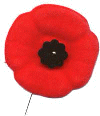
lest we
forget
|
a GlescaPals tribute to 'oor forces'
|
|
Highland Light Infantry
|
page5
page5a page5b page5c
|
...
|

|
16th Battalion Highland Light Infantry |
.
|
During World War One, in
response to Kitchener's Call to Arms, volunteer battalions were
formed.
One such battalion was the 16th Battalion HLI which was formed mostly
of members and ex-members of
The Boys' Brigade on the 2nd September 1914
by the Lord provost & the City of Glasgow.
The 16th (service) (2nd Glasgow) Battalion HLI
|
|
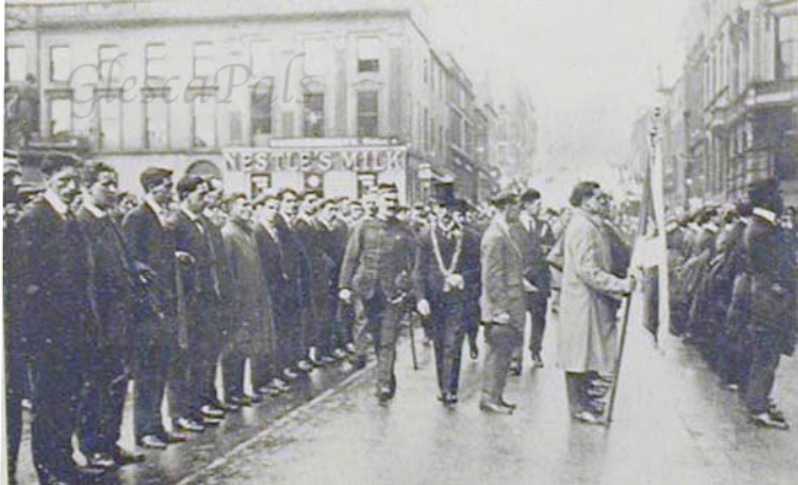
16th Highland Light Infantry on parade at
George Square in 1914
|
.
The Battalion was raised in Glasgow on
2nd September 1914 as the 2nd Glasgow by the Lord Provost and City with
many recruits from the Glasgow Boys' Brigade.
In May 1915 the Battalion moved to Prees Heath, in Shropshire, where it
joined the 97th Brigade of the 32nd Division HLI
The battalion suffered grievously during the first day of the Somme
when the 32nd Division attacked Thiepval, and when 16th HLI came out of
the line on the evening of July 3rd its casualties totalled 20 officers
and 534 other ranks. The chapter describing this is titled "The
Shambles of the Somme." And they were there again at the final battle
at the Ancre in November when their casualties amounted to 13 officers
and 390 other ranks. The 16th HLI was with the Army of Occupation. It
was a good battalion and this history does them credit. and
sailed for France in November 1915. It served with that brigade on the
Somme, on the Ancre and on the Flanders coast. In February 1918 it
became the divisional Pioneer Battalion. There is useful information in
the appendices: the Roll of Honour (36 officers and 795 dead), Honours
and Awards, roll of officers and of other ranks who embarked for France
with the Battalion on 23rd November 1915, and a list of officers who
served with the Battalion overseas (135). |
|
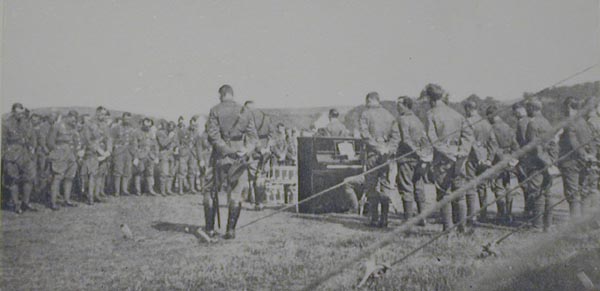
16th Highland Light Infantry church parade
|
..
|
The plaque below is on
the frontage of the Church of Authuille.
This village had a strong connection with the Highland Light Infantry
during the years 1915-1916.
The plaque, inaugurated on 1st July 1996, is dedicated to three
battalions of this regiment who carried out fatal attacks against
Thiepval and Leipzig Salient on 1st July 1916 :
15th (Glasgow Tramways), 16th (Boys Brigade) and 17th (Glasgow
Commercials).
The plaque exposes the extract of a
speech of the chaplain of the regiment, Rev A.H. Gray, during a
memorial service in Glasgow in July 1917. The plaque exists thanks to
the initiative and to the efforts of GlescaPal Charlie McDonald, of the Thistle
and Poppy Society, who launched a subscription..
|
|
32nd
DIVISION'S H.L.I. BATALLIONS MEMORIAL
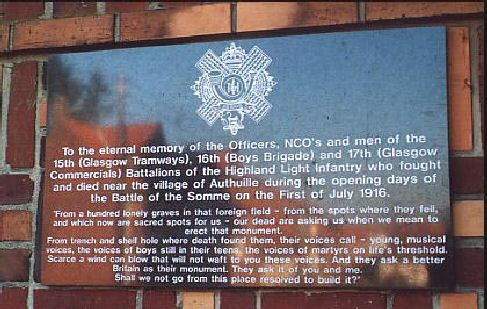
|
|
To the eternal memory of the officers,
NCO's and men of the
15th (Glasgow Tramways), 16th (Boys Brigade) and 17th (Glasgow
Commercials) Battalions of the Highland Light Infantry who fought
and died near the village of Authuille during the opening days of
the Battle of the Somme on the First of July 1916
"From a hundred lonely graves in that foreign field - from the spots
where they fell,
and which now are sacred spots for us - our dead men are asking us when
we mean to
erect that monument
From trench and shell hole where death found them, their voices call -
young, musical
voices, the voices of boys still in their teens, the voices of martyrs
on life's threshold.
Scarce a wind can blow that will not waft to these voices. And they ask
a better
Britain as their monument. They ask it of you and me.
Shall we not go from this place resolved to build it?".
|
1916 - Authuille, France - The Battle of the Somme
....was, in fact, a series of battles, commencing with the Battle
of Albert. It was fought to gain possession of one of the strongest
parts of the German line, known as the Leipzig Redoubt, and the 15th, 16th
and 17th H.L.I., in the trenches before Thiepval, all went into the
attack.
The 16th H.L.I. came up against intact wire, untouched by the
bombardment, and lost 19 officers and 492 rank and file within a few
hours. |
|
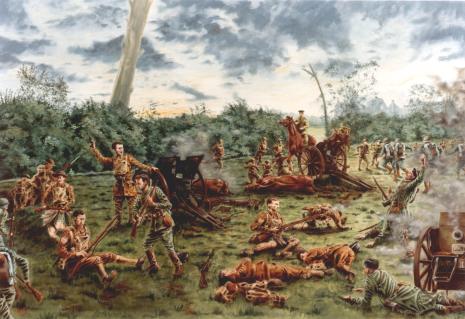
|
|
|
Mar.2008, Info sent from GlescaPal
Geordie, Thailand.
Frankfurt Trench Incident
The 16th Highland Light Infantry had been well and truly
blooded on that catastrophic first day of the Somme battles which cost
the Glasgow Boys Brigade Battalion over two-thirds of its strength,
including 20 out of 25 officers. Now, on 18th November, 1916, heavily
reinforced, mostly from the Highland Cyclist battalion, the Glaswegians
peered through swirling snow at the heights of Beaumont-Hamel. At 6.10
a.m. the barrage lifted and each man, laden down with half a
hundredweight of arms and equipment, including six bombs, 220 rounds of
ammunition and a trenching spade, heaved himself out of the jump-off
trench and into No Man's Land.
On the left flank the 2nd Manchesters, 2nd K.O.Y.L.I. and the 11th
Borders, after initial successes, were heavily counter-attacked and
beaten back. On the battalion's half right front an enemy strong point
of six to eight machine guns pinned down "A" and "B" companies. Only
"C" and "D" companies on the half left penetrated the German front
line, Munich trench. Three platoons of "D" company, leaving the rest to
clear their captured trench, pushed on to their second objective,
Frankfurt trench. Despite heavy shelling and vicious machine gun fire,
the second trench was stormed and its 50 surviving defenders made
prisoners and sent back under escort. This group reached Munich trench
in time for the guards to be shot down and the prisoners freed as the
mopping-up party, attacked from three sides by overwhelming numbers,
was rushed and destroyed. The attempted capture of the German first and
second trenches and the subsequent command of Beaumont-Hamel spur had
failed after heavy casualties (the 16th alone had lost 13 officers and
390 other ranks).
Now, with Munich trench cleared, the Germans no doubt considered that
the 32nd Division's assault had been completely repulsed. However,
unbeknown to the Germans, a battered remnant of Frankfurt trench was
still garrisoned by three officers and about 60 other ranks of the 16th
H.L.I., together with a few men from the 11th Borders. This party, with
Munich trench once more firmly held by the enemy, was now deeply
implanted in Gernlan territory.
By nightfall a number of stragglers had reached Frankfurt trench and
the community had grown to about 45 effectives and a similar number of
wounded. A dusk reconnaissance revealed that the trenches in front and
behind, together with the communication alleys on either flank, were
occupied by Germans and the garrison was isolated with very limited
resources. Two dugouts still existed in the battered trench, one was
allocated to the wounded, in charge of a corporal, and the fit men
accommodated in the second. There were four Lewis guns with a limited
number of rounds which were implemented from bandoliers of the dead
lying in the open. In addition, the men handed their own small arms
ammunition to the machine gunners and then armed themselves with
captured German rifles and cartridges. The machine gun N.C.O., Lance
Corporal Veitch, the son of a sergeant in the Scots Greys and a
survivor of the Somme holocaust, was to prove himself a tower of
strength and be recommended for the Victoria Cross. Bombs were not too
plentiful and food and water were both scarce, but in worst case of all
were the wounded. There were insufficient field dressings to cover all
the mangled flesh and, apart from occasionally easing the sufferer's
position, nothing could be done for those unfortunates with broken
bones and limbs.
By the second day the garrison had settled to a state of siege.
Collapsing trench walls had been revetted and machine gun emplacements
set at vital points. The senior N.C.O., Sergeant Lee, a Glasgow
Corporation roads foreman before the war and an original member of the
battalion, cheered and encouraged his men through the day. He too would
later be recommended for the V.C. That night a sergeant of the 11th
Borders crept through the enemy lines to bring succour. At dawn on the
third day, supported by trench mortar fire and bombs, the Germans made
a determined attempt to wipe out the puny garrison. By the time the
attack melted away the balance of strength in the trench had shifted
and there were now more wounded than fit men. Accordingly, the line was
shortened, the smaller dugout evacuated and, after dark, the routine
search for shell-hole water assumed a fresh urgency. That night a heavy
British barrage fell round the garrison, but after the first bursts of
small arms fire there was silence, the first relief had failed. Fresh
hope came on the fourth day when torch signals flashed from British
planes urged the garrison to hold out as help was on the way. The fifth
day saw the promised relief attack beaten back with over 300
casualties. Once again the garrison was driven underground by heavy
shelling, which blew in the dugout entrances and destroyed much of the
revetting.
Conditions in Frankfurt trench were rapidly worsening. Many of the
wounds were gangrenous and lack of sleep and food was blunting the
efficiency of the active men. On the afternoon of the sixth day, 23rd
November, the Germans launched a powerful attack from front and flanks
which almost succeeded. Unusually heavy shelling and the sentries'
warnings aroused the defenders, but it was difficult for exhausted men
to run up half-destroyed dugout steps. After a hand-to-hand struggle
with entrenching tools and bayonets the Germans were routed, leaving
behind them eight prisoners. One of the heaviest blows to the defence
was the loss of the indefatigable Lance Corporal Veitch, after the
fight was over, killed by a sniper's bullet as he manned his Lewis gun.
On the morning of the seventh day an Inniskilling Fusilier, captured in
one of the unsuccessful relief attempts, appeared waving a white flag
with a message from the German divisional commander. Roughly translated
it read "Surrender and get good treatment or stay where you are and be
killed".
After a short pause, presumably for reflection, the occupants of
Frankfurt trench were subjected to the heaviest bombardment they had
yet endured; one of the casualties was Sergeant Lee, killed by
shrapnel. That night the searchers found a pool of precious water and
several bottles were stealthily filled and passed back to the trench.
However, when it was poured it was so discoloured and gave off such a
villainous stench that the corporal in charge of the wounded refused to
give it to his casualties, in spite of their pleas. Just as well -
those who drank it contracted a virulent form of typhoid.
The promised German attack came on the eighth day, in force and from
every point of the compass. Sentries and machine gunners were shot down
or bombed as the listless effectives struggled from the dugout. The
process of sheer annihilation was only halted by screams from the eight
enemy prisoners. The last stand of "D" Company of the 16th H.L.I. was
over. Fifteen sick and exhausted men stumbled into captivity; the
remainder were painfully manhandled out on stretchers or buried where
they lay. Two of the wounded died on their way to prison camp and yet
another was shot by the Germans for accepting a piece of bread from a
Frenchwoman.
In 1919 the recommendation under Army Order 193 was sponsored by no
less a personage than General Sir Hubert Gough, commander of the Fifth
Army. The closing sentence of his letter to the War Office reads, "I
consider that these men deserve great recognition for the magnificent
example of soldierly qualities they displayed". It seems probable that
every survivor was decorated because the 16th received one D.S.O., two
M.C.s, II D.C.M.s and 22 M.M.s-the highest number of awards, by far, to
any one battalion. The two N.C.O.s, both recommended for the Victoria
Cross, each received a posthumous mention in despatches.
Distinguished Service Order Lieut.John Stewart
Military Cross Lieut. Malcolm M. Lyon , Lieut. Frank
Scott
Distinguished Conduct Medal (0) 14952 Cpl. P. E.
Browne, (0) 14811 Sergt. J. M. Buchan, 3579 L/Cpl. J. Eastop (0)
14661 L/Cpl. A. C. Fletcher, 43183 Pte. I. Fraser, 26203 L/Cpl.
G. McArthur, (0) 14493 Pte. J. McLay 27274 Pte. R. K. Mansen,
43155 Pte. D. Millar, (0) 14388 Pte. J. Mitchell, 43163 Pte.J.Smart
Mentioned in Despatches (0) 15154 Sergt. G. A. Lee,
(0) 14545 L/Cpl. J. Veitch
Military Medal 27252 Pte. G. Cairns 43161,
3563 Pte.J. Duncanson, 28779 Pte. G. Grant, 9345 Pte. W. Gunning 40546
Pte. A. Hay, 43144 Pte. J. Hughes, 45105 Cpl. (A/L. Sgt.) H.J. Lamb,
32681 L/Cpl.J. McAllister, 24571 Pte. R. McBride, 27250 Pte.J.
W.M. McGregor, (0) 14823 Pte. J. McGrottie, 30325 Pte. R. McKinley
(0) 1451 Pte. H. McInnes, (0) 3524 Pte. A. McPhee, 27270 Pte. J. F.
Manson, (0) 14398 Cpl.J. Reid, 43181 Pte. R. Shaw, 43161 Pte.J. Smart,
(0) 14287 Pte. A. Smith, 30306 Pte. J. Stevenson, 40542 Pte. T.
G. Steward, 43165 Pte. D. Whittet
.
Sept.2012, email from Alistair
McBride, England
Hi - I wonder if you can help me? I read with
great interest an article on the Frankfurt Trench action of
November 18th, 1916 written by GlescaPal Geordie from Thailand. My name
is Alistair McBride; my grandfather was Pte Richard McBride, one of the
brave men captured after that horrific action. Would be very keen to
get in touch with Geordie and find out any more details - do you have
an email address?
Many thanks.Alistair McBride
Webmaister : Geordie was happy to
speak to Alistair and I passed on the email addresses, however thus far
I haven't heard back from them.
Apr.2021, email from Richard McMillan, Age 45, London, England
I am the great-grandson of Lance-Corporal John Veitch's eldest brother,
Nathaniel Veitch, who survived the war. He was still alive when I was
very young but I never met him. I found your article most interesting,
for which I thank you.
|
| GlescaPal Geordie, Thailand. HLI medal collection |
|
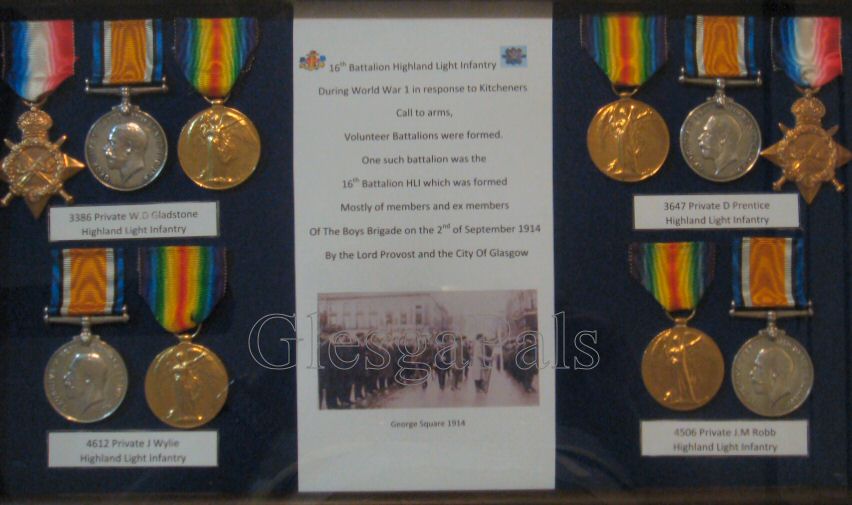
|
..
.
|

16th Highland Light Infantry on parade at
George Square in 1914
|
.
Extract from e-mail, June 2005, Celia, Canada
..........the new National War Museum at
Edinburgh Castle. One Article stood out, I knew would mean a lot to you
Webmaister. One of the most prized exhibit's is a battered trophy,
shield competed by the 62nd Glasgow Company. of the Boy's Brigade, in
memory of ex-member's killed in action in 1916, whilst serving with the
16th Battalion, Highland Light Infantry. It was known as the PALS
BRIGADE, as it was raised almost entirely, from boy's, who had been in
the BB. My husband, a Dalmarnock Rd guy, was a member of the BB
|
Extract from e-mail, Nov 2005, John Cooper, Glasgow
.......... a memorial honouring the 16th HLI was placed in BB House
(Bath Street) a number of years ago... It is now in the new BB HQ at
Ibrox Church, Clifford Street, Glasgow. |
June 2006 Extract from GP Messageboard, Charlie McD, Glasgow
Due to the response from many of you to my In Flanders
Field post and several PM's it is obvious that there are many 'Glesga
Pals' out there who have had family members who have been involved in
some capacity or another in The Great War. Alas due to no records or
other family members still alive to tell the tale you are unsure of
where your great uncle's or long lost family members are buried or
commemorated.
The Pals Battalions
On the outbreak of war in August 1914 the British Army
was a small professional body made up of Regulars and Territorials who
formed the immediate reserve. Lord Kitchener was one of the few public
officials to refute the idea that the war would all be over by
Christmas and set about forming a new army, made up of volunteers. Your
Country Needs You proclaimed the recruiting posters and in a frenzy of
patriotism thousands joined. Many of these new battalions were made up
of men who joined up as a group: perhaps by town, perhaps by trade.
They would always refer to themselves as a pals battalion regardless of
what the Army wanted to call them.
The 15th Glasgow Tramways ( The Boozy First) , 16th
Glasgow Boys Brigade(The Holy Second) and the 17th Glasgow Commercials
(The Featherbeds) Battalions were never called 'The Glasgow Pals'...the
only one reference I have ever came across calling them that was in the
programme for the play 'The Big Picnic' ...this reference was by
Professor Hew Strachan but I doubt if the good Professor ever read this
anywhere and just used it a generalisation in reference to the Pals
Battalions which were being recruited all over Britain though mainly in
the North of England.
Anyway I usually get to the small hamlet of Authuille
just outside Albert every 1st of July and lay a wreath at the H.L.I
Memorial which I had unveiled on the 80th Anniversary in 1996. The
wreath is a private and personal thing I do in memory of 'ma boys' from
the 15th , 16th & 17th - I have a list of the names and index card
of every one of them where they were born , name rank and number and
sadly in many cases photos of where they are buried. Authuille is a
small rural village and only used as a means to get up to the Thiepval
Ridge by many Great War enthuisasts although it does have two beautiful
cemeteries - where a certain Private William McBride is buried - there
is actually two soldiers of the same name buried there but neither of
them are the Willie McBride of Eric Bogle's ballad.
Pipers
Memorial - see the story and picture of the Authuille Memorial
to the H.L.I. on this webpage ( see above )
Anyway this year apart from my usual wreath laying
ceremony at Authuille I will lay one at the Thiepval Memorial To The
MIssing and one at the 9th H.L.I. (Glasgow Highlanders ) Battalion
Memorial at High Wood - my granda's regiment.
The
Thiepval memorial
Which means I have a spare Poppy Wreath to use up...so I
will lay it at the Menin Gate Memorial to The Missing in Ipres/ Ypres
on behalf of the Glesga' Pals. When we do these wee wreath laying
ceremonies we usually read out a wee list of The Fallen and also those
who fought and survived in all conflicts that the British Army were
involved in from the Great War , the Second World War , Palestine ,
Korea , Cyprus , Aden , the Falklands , Northern Ireland , Afghanistan
and up to the present day conflict in Iraq. So if any Glesga Pals would
like to have a name read out in our Remembrance Ceremony then please
send me their name , rank and number plus any whereabouts of a grave if
they were killed.
Menin Gate Memorial
..........my offer is still open to any of you who
would like a photo of your loved ones grave in France or Flanders. It
will take time but I will get them for you I promise.  Lest We Forget
........... Charlie McDonald Lest We Forget
........... Charlie McDonald
|
.
Nov 2006 Extract from GP Messageboard, Charlie McD, Glasgow
........the 18th of November is traditionally
known as Battalion Day in Glasgow in memory of the 16th (Glasgow
Boys Brigade) Battalion of the Highland Light Infantry. For
many years the veterans of the regiment would form up at the Cenotaph
in George Square to remember the deeds and valour of their fallen
comrades in the action known as New Munich and Frankfurt Trench in the
last week of the Somme in 1916.
So all you former members of the Boys Brigade take sometime out during
the day to remember the Boys of the Old Brigade. I will remember them
at sometime tomorrow when I visit George Square.............Sure and
Stedfast |
Feb.2008
Extract from email .. John McKinley webmaster St.James Church Pollok.
I am the current administrator for the St James' (Pollok) Parish
Church. I would like to ask if it is possible to either link to your
website Forces page 5a for this section on the 16th Battalion
Highland Light Infantry as this has some significance to the
church. |
| |
St
James' (Pollok) Parish Church. has a stained glass window depicting the
first and second world wars and since its the Boys Brigades 125th
celebrations this year I thought it would be poignant to have this as
part of the website as my father was a member of The Royal Highland
Fusiliers as the HLI was part of it. |
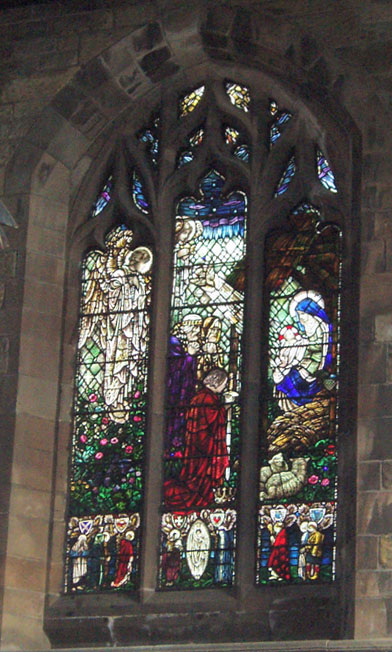
photo by Dr John Mann - St James'
minister/pastor |
..
.
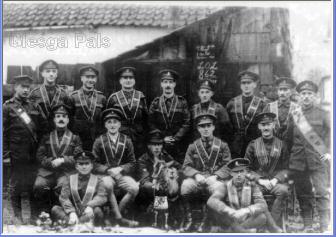 |
Ulstermen after the
Battle of the Somme.
click on
photo
for more details.
|
..
|